Mother Jones: ‘the most dangerous Irish woman in America’
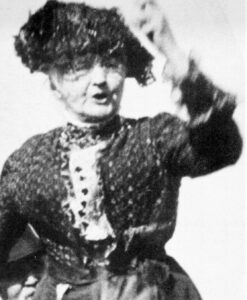
By John Joe McGinley
Mary Harris Jones, a proud Cork woman, was a teacher, seamstress, labour activist and union organiser.
A champion of the underdog and the working-class, Jones was a campaigner for the United Mine Workers Union, founded the Social Democratic Party and helped establish the Industrial Workers of the World. Mary was an inspirational icon for any distressed strikers and used to clad herself in typical black Victorian dresses, which made her look older than she was.
She was given the title of Mother Jones by striking miners grateful for the support and leadership she had shown them. Jones in turn referred to the miners as ‘my boys.’ During one of her numerous trials for labour activism, a US Attorney once called Jones the ‘most dangerous woman in America.’ (1)
Mary Harris Jones, a proud Cork woman, was a teacher, seamstress, labour activist and union organiser throughout her long life.
Mother Jones was revered by many in the working class as a saint while to the establishment believed she was the ‘devil disguised as a grey-haired old lady’. Jones was imprisoned many times for her role in the labour movement and for what was perceived as subversive activity. However, imprisonment held no fears for Jones who proclaimed
“I can raise more hell in jail than out.” (2)
Early life
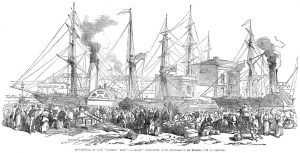
Details of Mary’s early life are scarce, she was born Mary Harris in county Cork. While her date of birth is subject to debate what is known is that she was baptised on 1st August 1837.
Her parents were Roman Catholic tenant farmers Richard and Ellen Harris.
Like many of their fellow Irish men and women, they faced a stark choice as the famine struck the land in the 1840’s, starve or emigrate. The Harris family decided to emigrate, sailed to Canada and settled in Toronto.
Mary Harris emigrated to Canada in the 1850s and found work first as a teacher and then as a seamstress before marrying railway worker Robert Jones
Richard Harris tried many professions to help raise his family, starting out as a milk man and ending up as a railway worker. Mary and her family were victims of the prevailing anti-Catholicism in Toronto that must have made the young Mary, educated in a convent school, seem at times like an outcast.
She left Toronto in August 1859 to start a teaching post at a convent school in Monroe Michigan. Despite it being a well-paid and secure position, Mary would later describe it as a depressing place. She left the convent and accepted work as a seamstress in Chicago with the aim of becoming a professional dressmaker, before accepting another teaching position in Memphis Tennessee.
In 1861, she met and married Robert Jones, an Iron worker and a committed union man active in the iron moulders union. The newlyweds enjoyed relative prosperity and Mary left teaching to raise her young and expanding family. In four years, she gave birth to 3 girls and a boy.
Fate has a cruel way of ending happiness and forging your future and in 1867 Mary experienced an unspeakable tragedy that would shape the rest of her life.
In 1867 a yellow fever epidemic killed her husband and four children. Thereafter she devoted her life to union activism
In 1867 a yellow fever epidemic swept through Memphis, killing her husband Robert and her four young children. At 37 Mary Jones life was devastated, heartbroken she would dress in black for the rest of her life.
The grief-stricken widow moved back to Chicago. She set up as a seamstress and began working for the city’s wealthy. However, her marriage to Robert Jones had radicalised her and she bitterly noted the contrast between the ”luxury and extravagance” of the few and the misery of the ”poor, shivering wretches” she saw on the streets especially the children, who reminded her of her loss.
Activism
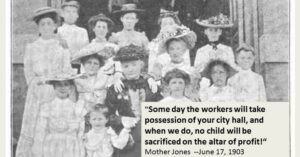 While she began rebuilding her life, tragedy was to strike again for Mary Jones, she lost her home, shop, and possessions in the great Chicago Fire of 1871. This huge fire destroyed many homes and shops. Jones, like many others, helped rebuild the city.
While she began rebuilding her life, tragedy was to strike again for Mary Jones, she lost her home, shop, and possessions in the great Chicago Fire of 1871. This huge fire destroyed many homes and shops. Jones, like many others, helped rebuild the city.
After this latest loss, Mary began her work as a labour activist. Mary Jones found in the lives of the downtrodden, a new family to nurture and support. She turned to the Union Knights of Labour for assistance, attracted by their campaign for improved working conditions and dedicated her life to campaigning for working people.
Subject to so much grief and tragedy Jones could have hidden from the world and wallowed in self-pity but instead she found a new purpose in life. Mary dedicated her new life as a trade union organiser, a feminist, and a campaigner against child labour in America. Her rallying cry would be: “Pray for the dead and fight like hell for the living.” (3)
Mary Jones became an activist in the Knights of Labour, travelling to strikes across America.
From 1873-1877, Jones actively supported workers in achieving their demands. She used to travel to various strike sites and instil more passion into their disputes. She helped the coal miners’ strike in Pennsylvania and railroad workers.
Jones joined strikers in the coal mines of Pennsylvania in 1873. There she witnessed appalling conditions and children near starvation. Her own Irish heritage caused her to work passionately on behalf of the mostly Irish workers. It was her kindly, protective concern for the workers in the Pennsylvania coal mines that earned her the nickname “Mother Jones.”
Jones went across the east coast of America fighting injustice and she travelled so much she commented:
“My address is like my shoes. It travels with me. I abide where there is a fight against wrong.” (4)
Mary first displayed her oratorial and organisational skills during the great railroad strike of 1877. America was in the fourth year of a prolonged economic depression after the panic of 1873. The railroad strikes were precipitated by wage cuts announced by the Baltimore and Ohio (B&O) Railroad. This was its second cut in just eight months. Jones helped organise the initial strikes in West Virginia, rallying men to action.
On July 16th, 1877, workers at the B&O station at Martinsburg, West Virginia, responded to the announcement of a 10 percent wage cut by uncoupling the locomotives in the station, confining them in the roundhouse, and declaring that no trains would leave Martinsburg unless the cut was rescinded. West Virginia Governor Henry M. Mathews dispatched the militia when police were unable to break up the supportive crowd that had gathered.
However, the militia proved incapable of freeing the 600 or so trains stranded in Martinsburg (perhaps because many of the militiamen were themselves railroad workers sympathetic to the strike). Mathews then requested and received assistance from federal troops. After their arrival, trains were able to begin leaving Martinsburg on July 20th.
Meanwhile, the strike had begun spreading along the mainline of the B&O all the way to Chicago, and on July 19th, it grew to include Pittsburgh and the Pennsylvania railroad.
in Pittsburgh, when local police and national guard units were reluctant to act against their fellow townsmen, Pennsylvania Governor John F. Hartranft called in national guardsmen from Philadelphia. On July 21st, after local forces had made only a token effort to clear the tracks of the growing mob, the troops from Philadelphia made a bayonet charge.
A riot then erupted, with guns fired on both sides, and as many as 20 deaths resulted. As anger swelled among the workers, the guardsmen withdrew into a roundhouse while the crowd set fire to the Pennsylvania Railroad’s engines, cars, and buildings. Gunfire was exchanged through the next night, with 20 more crowd members being killed, along with five guardsmen. A virtual general strike ensued in the city, with iron and steel workers, miners, and labourers joining the action.
Although the entire national guard of Pennsylvania was summoned, many units were delayed in arriving by the actions of strikers in other towns in the state. In Harrisburg, factories and stores were closed. In Lebanon, a national guard company mutinied, and in Reading, a mob tore up tracks, derailed cars, and set fires. Nevertheless, by July 29th a fresh contingent of the national guard, supported by federal troops, had brought calm to Pittsburgh and reopened railroad operations. (5)
In 1880 Jones was in Chicago on behalf of workers trying to obtain an eight-hour day. Everywhere she went, she was now called Mother Jones, for her mother-like image. She was around 60 years old by this time.
Jones strongly opposed abortion and female suffrage. believing that women’s primary duty was to look after the children at home.
Jones strongly opposed abortion and female suffrage. She believed that women should not take an active role in politics or for that matter work in factories and mines because their primary duty was to look after the children at home.
Jones was ideologically separated from many female activists of the pre-Nineteenth Amendment days due to her views on female suffrage. She was quoted as saying that.
“I have never had a vote, and I have raised hell all over this country. You don’t need a vote to raise hell! You need convictions and a voice”! (6)
She opposed many of the activists because she believed it was more important to liberate the working class itself. When some suffragettes accused her of being anti-women’s rights, she clearly articulated herself,
“I’m not anti to anything which brings freedom to my class.” (7)
A friend of Jones, wrote of her:
“All over the country she had roamed and wherever she went, the flame of protest had leaped up in the hearts of men; her story was a veritable Odyssey of revolt.” (8)
This odyssey would next take her to the Haymarket riot in Chicago in 1886.
Haymarket
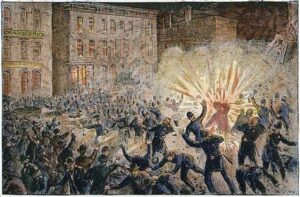
On May 4th, 1886, a rally at Haymarket Square in Chicago was organised by labour radicals to protest at the killing and wounding of several workers by the Chicago police during a strike the day before at the McCormick reaper works.
The rally turned into a full-scale riot when a bomb was thrown killing several policemen. In the mayhem, police fired randomly into the demonstrating union workers, killing 11 people and wounding dozens of others.
In August 1886, eight men labelled as anarchists were convicted in a sensational and controversial trial in which the jury was considered to be biased and no solid evidence was presented linking the defendants to the bombing. Judge Joseph E. Gary imposed the death sentence on seven of the men, and the eighth was sentenced to 15 years in prison. On November 11th, 1887, four of the men were hanged.
A bloody riot at Haymarket in Chicago in 1886, after which eight union activists were executed for the killing of policemen caused the demise of the Knights of Labour
Of the additional three who were sentenced to death, one committed suicide on the eve of his execution and the other two had their death sentences commuted to life in prison by Illinois Governor Richard J. Oglesby. The governor was reacting to widespread public questioning of their guilt, which later led his successor, Governor John P. Altgeld, to pardon the three activists still living in 1893. (9)
One other immediate impact of the Haymarket riot was that the ‘Knights of Labour’ started to break down. Jones wished to continue her labour activism and now became associated with the United Mine Workers.
Miners’ Union and Childrens’ March
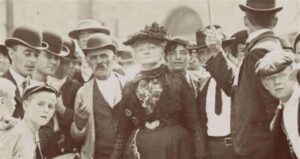
The union was certainly needed as conditions for mine workers were atrocious.
In 1894 Jones joined with Jacob Coxey’s Army of 500 unemployed citizens who marched on Washington D.C. to protest at the effects of the crippling economic depression. In 1898 She was one of the founders of the short lived Social Democratic Party which was a predecessor to the Socialist Party of America which was established in 1901.
During the bitter 1989–90 Pittston Coal strike in Virginia, West Virginia and Kentucky, the wives and daughters of striking coal miners, inspired by the still-surviving tales of Jones’s legendary work among an earlier generation of the region’s coal miners, dubbed themselves the “Daughters of Mother Jones”. They played a crucial role on the picket lines and in presenting the miners’ case to the press and public.
Mother Jones as she was now known, was called ‘the most dangerous woman in America’ for her role in encouraging strikes.
In 1899 Jones published The New Right in 1899 and a two-volume Letter of Love and Labour in 1900 and 1901.
Now universally known as Mother Jones and in her 60’s, Mary was not constrained by age and was continuing her travel and work with the United Mine Workers union.
In 1901 workers in Pennsylvania’s silk mills went on strike. Mother Jones went to north-east Pennsylvania to encourage unity among the striking workers. She also encouraged the wives of the workers to organise into groups that would wield brooms, beat on tin pans, and shout “join the union!” She believed that wives had an important role to play in motivating the striking men.
In 1902, at her trial in a West Virginia court for ignoring an order that banned the meetings by striking miners, the Virginian district attorney, Reese Blizzard, addressed her as: ‘The most dangerous woman in America.’ (10)
He went on to say: “She comes into a state where peace and prosperity reign … crooks her finger and twenty thousand contented men lay down their tools and walk out.” (11)
Mother Jones was appalled at the treatment of children in America and in 1903, to protest at the lax enforcement of the child labour laws in the Pennsylvania mines and silk mills, she organized a children’s march from Philadelphia to the home of President Theodore Roosevelt in New York.
Permission to see President Roosevelt was denied by his secretary, and it was suggested that Jones address a letter to the president requesting a visit with him. Even though Mother Jones wrote a letter asking for a meeting, she never received a reply.
Industrial Workers of the World
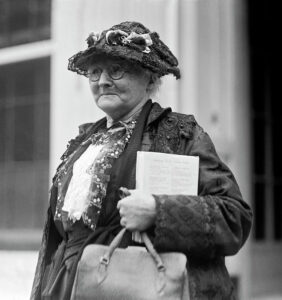 In 1905 Jones helped establish the Industrial Workers of the World. This was a labour organisation founded in Chicago by representatives of 43 groups. The IWW opposed the American Federation of Labour’s acceptance of capitalism and its refusal to include unskilled workers in craft unions.
In 1905 Jones helped establish the Industrial Workers of the World. This was a labour organisation founded in Chicago by representatives of 43 groups. The IWW opposed the American Federation of Labour’s acceptance of capitalism and its refusal to include unskilled workers in craft unions.
Now in her 80s, Mother Jones continued her labour activities. In 1912 she participated in the Paint Creek–Cabin Creek strike which was a brutal confrontation between striking miners and the mine owners in Kanawha county West Virginia. Jones used her oratory skills to rally the strikers and helped organise them as they faced a shooting war against the private army hired to break the strike.
Such was the violence, that martial law was declared and rescinded twice before Jones was arrested on 13th February 1913 and brought before a military court. She was accused of conspiring to commit murder among other charges, Jones refused to recognise the legitimacy of her court-martial declaring:
In 1905 Jones helped establish the Industrial Workers of the World in 1905
“If they want to hang me, let them. And on the scaffold, I will shout, Freedom for the working class”! (12)
During house arrest at Mrs. Carney’s boarding house, she acquired a dangerous case of pneumonia. On her recovery, Mother Jones was convicted of conspiracy to commit murder and was sentenced to 20 years in the state penitentiary.
She would later recount that:
“I asked a man in prison once how he happened to be there, and he said he had stolen a pair of shoes. I told him if he had stolen a railroad, he would be a United States Senator.” (13)
Her supporters could not let their heroine rot in jail, and they campaigned to successfully convince the governor to commute her twenty-year sentence. After 85 days of confinement, her release coincided with Indiana Senator John W. Kern’s initiation of a Senate investigation into the conditions in the local coal mines.
Several months later, she helped organise coal miners in Colorado in the 1913-1914 United Mine Workers of America strike against the Rockefeller-owned Colorado Fuel and Iron company, in what is known as the Colorado Coalfield War.
Once again, she was arrested, serving time in prison and inside the San Rafael Hospital. She was escorted from the state in the months prior to the Ludlow Massacre perpetrated by anti-striker militia during the Colorado Coalfield war, in which at least 25 people were killed.
After the massacre, she was invited to meet face-to-face with the owner of the Ludlow mine, John D. Rockefeller Jr. The meeting was partially responsible for Rockefeller’s 1915 visit to the Colorado mines and introduction of long-sought reforms.
Jones was denounced on the floor of the U.S. Senate as the: “Grandmother of all agitators”. She replied: “I hope to live long enough to be the great-grandmother of all agitators.” (14)
Jones was also a major influence on Irish republican and socialist leader James Connolly who was already aware of Mother Jones before he went to the US where he lived from 1905 until 1910.
Connolly and Jones took a similar path, moving from the Socialist labour Party to the Socialist Party of America and the Industrial Workers of the World so they were often crossing paths.
No correspondence exists between Connolly and Jones, but she certainly cheered the Irish rebellion and joined in hopes for a worker’s republic in Ireland, in the US and the world.
In 1925, she published her Autobiography of Mother Jones.
A woman of astonishing vigour, she marched three blocks in a miners’ parade at age 83. In her 90s, she returned to Chicago to work at organising dressmakers.
In 1930, she celebrated her self-proclaimed 100th birthday. She was living with her friends Walter and Lillie May Burgess in Adelphi, Maryland and was filmed making a newsreel statement calling for workers to rally to transform an unjust society that had fallen into the Great Depression.
Death
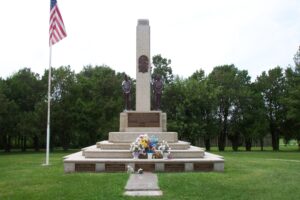
She died on November 30th of that year. With the workers to the end, she asked to be buried in the Miners Cemetery in Mount Olive, Illinois, alongside miners who died in the 1898 miners’ strike ‘Battle of Virden’. These were men she had always called my boys.
She died aged over 100 in 1930
On 11th October 1936, also known as Miners’ Day, an estimated 50,000 people arrived at Mother Jones’s grave to see a new gravestone and memorial erected. Since then, 11th October is not only known as Miners’ Day but is also referred to and celebrated in Mount Olive as “Mother Jones’s Day.
In her own words: “Someday the workers will take possession of your city hall, and when we do, no child will be sacrificed on the altar of profit.” (15)
No wonder those in power thought she was so dangerous.
Sources:
- Sandra L. Ballard: Patricia L. Hudson Listen Here: University Press of Kentucky September 2013.
- The Autobiography of Mother Jones Mary Jones 1925
- The Autobiography of Mother Jones Mary Jones 1925
- The Autobiography of Mother Jones Mary Jones 1925
- Pages from US Labor History: The Great Railroad Strike of 1877 Josh Shelton May 2008
- The Autobiography of Mother Jones Mary Jones 1925
- The Autobiography of Mother Jones Mary Jones 1925
- The American Journal of Irish Studies
- “The Haymarket Affair”. illinoislaborhistory.org. October 27, 2017.
- Sandra L. Ballard: Patricia L. Hudson Listen Here: University Press of Kentucky September 2013.
- Sandra L. Ballard: Patricia L. Hudson Listen Here: University Press of Kentucky September 2013.
- The Autobiography of Mother Jones Mary Jones 1925
- The Autobiography of Mother Jones Mary Jones 1925
- The Autobiography of Mother Jones Mary Jones 1925
- The Autobiography of Mother Jones Mary Jones 1925